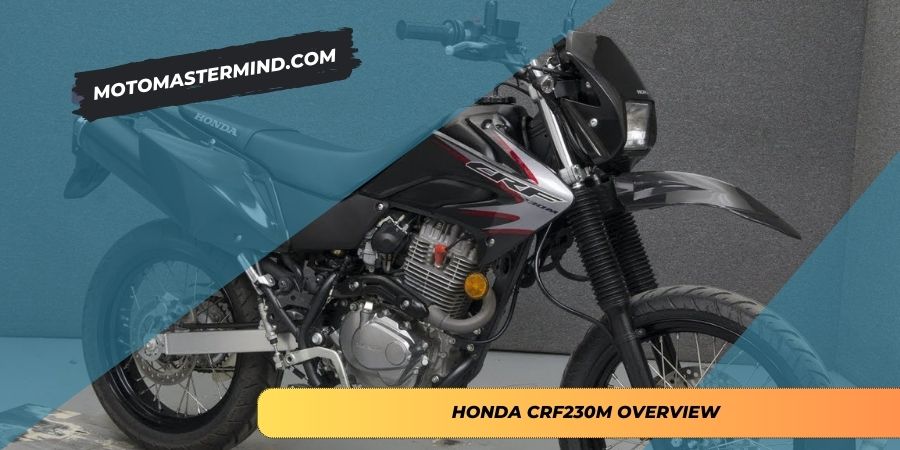
Honda CRF230M Overview

| Category | Specification |
|---|---|
| Engine and Transmission | |
| Displacement | 223cc |
| Engine Type | Air-cooled single-cylinder four-stroke |
| Bore and Stroke | 65.5mm x 66.2mm |
| Compression Ratio | 9.0:1 |
| Valve Train | SOHC; two-valve |
| Induction | Carburetor 30mm CV |
| Ignition | CD |
| Transmission | Six-speed |
| Final Drive | #520 O-ring – sealed chain; 13T/38T |
| Chassis and Dimensions | |
| Suspension (Front) | 37mm leading-axle Showa fork; 9.0 inches of travel |
| Suspension (Rear) | Pro-Link Showa single shock with spring preload adjustability; 6.6 inches of travel |
| Brakes (Front) | Single 240mm disc |
| Brakes (Rear) | 220mm disc |
| Tires (Front) | 110/70-17 Dunlop GT401 Arrowmax |
| Tires (Rear) | 130/70-17 Dunlop GT401 Arrowmax |
| Wheelbase | 52.6 inches (1336mm) |
| Rake (Caster Angle) | 23.9° |
| Trail | 3.58 inches (91mm) |
| Seat Height | 31.7 inches (805mm) |
| Ground Clearance | 9.3 inches (235mm) |
| Fuel Capacity | 2.3 gallons, including 0.7 gallon reserve |
| Curb Weight | 276 pounds |
1. The Suzuki Pioneer:
The DRZ400SM by Suzuki has been a staple for several years, epitomizing the essence of grassroots supermotos. These bikes are dirt bikes modified with reduced suspension travel and equipped with 17-inch wheels to accommodate sportbike-sized performance tires. 👀Look at this: Honda Big Ruckus Top Speed, Review, Pros & Cons2. Kawasaki’s Entry:
Kawasaki introduced the KLX250SF, a supermotard version of the KLX250S, marking their foray into the supermoto segment. This move was closely followed by Yamaha’s fuel-injected WR250X, which has become a class favorite.3. Honda’s Take:
Honda’s CRF230L dualie transformed similarly to Kawasaki and Yamaha’s lightweight bikes. The 230L, with its air-cooled, SOHC, 223cc engine, was thoroughly tested in the 2008 Lightweight Dual Purpose Shootout, showcasing its capabilities despite its lower power.4. The 2009 Honda CRF230M:


